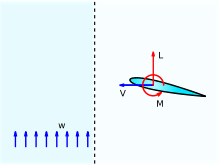Küssner effect

In fluid dynamics, the Küssner effect describes the unsteady aerodynamic forces on an airfoil or hydrofoil caused by encountering a transverse gust. This is directly related to the Küssner function, used in describing the effect. Both the effect and function are named after Hans Georg Küssner (1900–1984), a German aerodynamics engineer.[1]
Küssner derived an approximate model for an airfoil encountering a sudden step-like change in the transverse gust velocity — or, equivalently, as seen from a frame of reference moving with the airfoil: a sudden change in the angle of attack. The airfoil is modelled as a flat plate in a potential flow, moving with constant horizontal velocity.[2] For this case he derived the impulse response function — known as Küssner function[3] — needed to compute the unsteady lift and moment exerted by the air on the airfoil.
Notes
References
- H.G. Küssner (December 20, 1936), "Zusammenfassender Bericht über den instationären Auftrieb von Flügeln (Summary report on the instationary lift of wings)", Luftfahrtforschung (in German) 13 (12): 410–424
- Ernst H. Hirschel; Horst Prem; Gero Madelung (2004), Aeronautical Research in Germany: From Lilienthal until Today, Springer, p. 287, ISBN 978-3-540-40645-7
- Tuncer Cebeci (2005), Analysis of Low-speed Unsteady Airfoil Flows, Springer, pp. 15–16 & 52, ISBN 0-9668461-8-4
- Raymond L. Bisplinghoff; Holt Ashley; Robert L. Halfman (1996), Aeroelasticity (revised ed.), Dover, pp. 281–286, ISBN 0-486-69189-6
- John M. Eggleston (1956), Calculation of the forces and moments on a slender fuselage and vertical fin penetrating lateral gusts (PDF), NACA Technical Note 3805 Page 3
- Beerinder Singh; Inderjit Chopra (September 2008), "Insect-Based Hover-Capable Flapping Wings for Micro Air Vehicles: Experiments and Analysis", AIAA Journal 46 (9): 2115–2135, Bibcode:2008AIAAJ..46.2115S, doi:10.2514/1.28192
- L.M. Laudanski (July 2000), "Random disturbances, airplane loads and its fatigue life", Probabilistic Engineering Mechanics 15 (3): 233–240, doi:10.1016/S0266-8920(98)00020-4
External links
- E.C. Pike (Ed.) (1971), Manual on Aeroelasticity. Subject and author index (PDF), NATO AGARD Report 578 Page 13.
- Küssner function, Georgia Institute of Technology, retrieved 10 March 2009